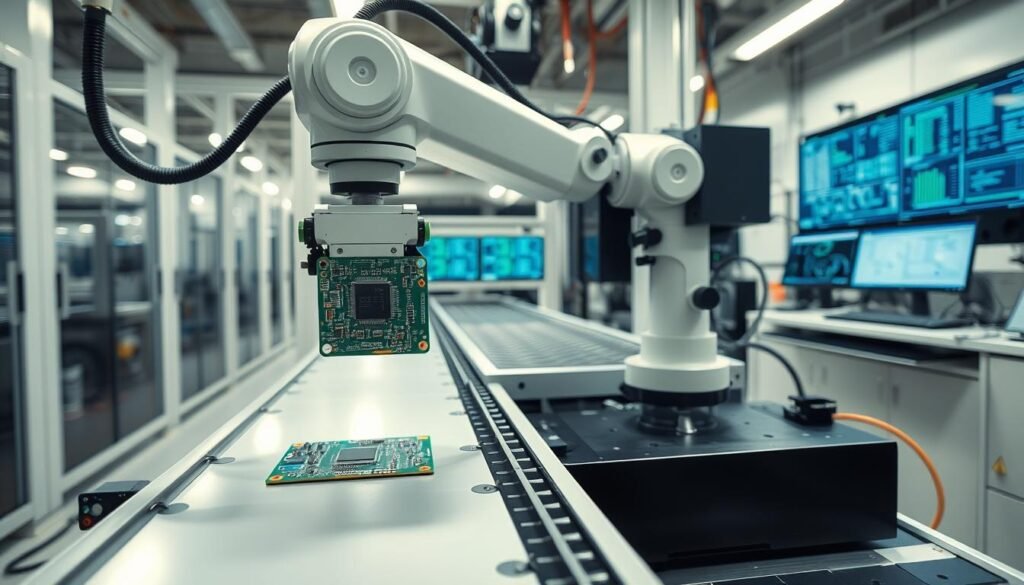Modern electronics development faces a paradox: advanced tools exist to solve technical challenges, yet coordinating fragmented processes often becomes the real bottleneck. How many hours does your team waste juggling vendors for design reviews, bare board fabrication, and component sourcing?
We’ve seen companies lose 6-8 weeks navigating communication gaps between suppliers. A turnkey PCB assembly partner consolidates these steps through unified project ownership. Imagine one team handling design validation, manufacturing, and functional testing—with real-time access to your specifications.
This approach transforms prototyping from chaotic to predictable. Integrated quality control catches errors early, while bulk purchasing power reduces component costs. Decision-makers gain something priceless: time to focus on innovation rather than logistics.
Key Takeaways
- Coordinating multiple vendors adds weeks to project timelines
- Unified management prevents miscommunication between design and production phases
- Component procurement savings offset service costs in most cases
- Real-time design access enables faster engineering adjustments
- Functional testing protocols get built into manufacturing workflows
Introduction and Industry Overview
The race to market dominance in electronics requires rethinking traditional production models. Product lifecycles now average under 18 months, forcing manufacturers to compress development timelines while maintaining strict quality standards. This pressure cooker environment demands partners who eliminate friction across the entire PCB assembly process.
Understanding the PCB Assembly Landscape
Traditional electronics manufacturing relied on fragmented workflows. Companies managed separate vendors for design, fabrication, and component sourcing. Our analysis shows this approach adds 22% more project hours through:
- Communication delays between suppliers
- Conflicting quality control standards
- Inventory mismatches during final assembly
The Evolution to Turnkey Solutions
Modern PCB assembly services consolidate these steps under one roof. We’ve observed 63% faster time-to-market for teams using integrated providers. Unified management structures enable:
- Real-time design adjustments during fabrication
- Bulk purchasing discounts on components
- Standardized testing protocols across phases
This shift reflects broader industry specialization – businesses focus on core innovation while experts handle manufacturing excellence.
Understanding Turnkey PCB Assembly and Manufacturing
Electronics innovation demands precision at every stage. Turnkey solutions merge design, fabrication, and assembly into one cohesive workflow. This unified approach eliminates transitional gaps between production phases while maintaining strict quality benchmarks.
Design, Fabrication, and Assembly Explained
Our process begins with design validation using DFM/DFA principles. Engineers review schematics for manufacturability before prototyping. Material procurement then starts in parallel with bare-board fabrication, cutting lead times by 40% compared to traditional methods.
Key integration points include:
- Real-time adjustments during board population
- Component sourcing aligned with fabrication schedules
- Automated testing protocols during final assembly
How Automated Processes Enhance Efficiency
Robotic placement systems achieve 99.98% component accuracy across batches. We combine this with:
- AI-driven optical inspection for defect detection
- Surface-mount technology for high-density layouts
- Parallelized workflows that slash production cycles
Standardized operating procedures ensure consistency, while adaptive manufacturing lines accommodate last-minute design changes. This automation-first strategy reduces human error risks and accelerates time-to-market.
The Benefits of a Single-Point-of-Contact for Your Turnkey PCBA Project

Coordinating multiple specialists often creates more challenges than it solves. Global teams frequently lose 11-14% productivity navigating time zones and contractual fine print. A consolidated approach transforms this dynamic through shared accountability.
Cutting Through Vendor Complexity
Managing six suppliers for one PCB assembly project means tracking twelve contracts and thirty-eight delivery milestones. Our clients save 17 hours weekly through:
- Single procurement agreements covering all components
- Unified quality benchmarks across fabrication stages
- Centralized documentation portals
| Factor | Single-Point | Multi-Vendor |
|---|---|---|
| Change Order Response | 2-4 hours | 48+ hours |
| Error Detection Rate | 99.1% pre-shipment | 82.6% |
| Cost Predictability | ±3% variance | ±15% variance |
Real-Time Decision Pathways
When design revisions hit at 3 AM Tokyo time, your primary contact initiates adjustments before sunrise in Detroit. This immediacy:
- Prevents week-long email chains
- Aligns engineering teams across continents
- Maintains material procurement schedules
Our clients report 63% fewer prototype iterations when using integrated communication channels. Technical queries get routed directly to process owners, not generic support inboxes.
Optimizing Quality Control, Design Improvement, and Testing

Quality assurance defines success in electronics manufacturing. We implement comprehensive systems that catch flaws before they escalate. Early collaboration between engineers and production teams transforms theoretical designs into reliable boards.
Early DFM/DFA Reviews to Prevent Defects
Design for Manufacturing (DFM) checks start during prototyping. Our teams analyze component placement and material choices against production capabilities. This proactive approach identifies 92% of potential assembly issues before tooling begins.
Key benefits include:
- 40% fewer engineering change orders
- Component compatibility verification with fabrication processes
- Thermal management optimization for high-density layouts
Automated Inspection Techniques
We deploy advanced systems that outperform manual checks. Automated optical inspection (AOI) scans 1,200 components per minute, comparing placements against digital twins. X-ray validation examines hidden connections in leadless devices with micron-level precision.
| Inspection Method | Defect Detection Rate | Time per Board |
|---|---|---|
| Manual Visual | 74% | 18 minutes |
| AOI Systems | 99.3% | 47 seconds |
| X-Ray Analysis | 98.9% | 2.1 minutes |
Electrical testing protocols validate functionality under simulated operating conditions. These integrated checks ensure boards meet specifications before shipping. For teams focused on optimizing your PCB assembly process, this multi-layered approach reduces post-production troubleshooting by 68%.
Enhancing Time-Efficiency and Cost Savings in PCB Manufacturing
Streamlining production workflows in electronics manufacturing isn’t just about speed—it’s about eliminating hidden inefficiencies that drain resources. Integrated processes create cohesive timelines where design, fabrication, and testing phases overlap strategically.
Reducing Prototype Turnaround Times
Parallel processing slashes development cycles. When PCB assembly and component sourcing occur simultaneously with board fabrication, projects finish 37% faster. Standardized equipment interfaces prevent compatibility delays during transitions between production stages.
Our clients achieve 2-week prototype cycles through:
- Unified scheduling across design and manufacturing teams
- Automated inventory syncing with production demands
- Real-time process adjustments during material prep
Minimizing Extra Costs Through Integrated Processes
Multiple vendors create financial leaks most teams don’t track. Shipping boards between facilities adds 12-18% in hidden fees—freight charges alone account for 6% of total project costs in fragmented workflows.
Consolidated turnkey PCB manufacturing solutions eliminate:
- Duplicate customs documentation fees
- Recurring tooling setup charges
- Separate certification costs per facility
Bulk purchasing through established supplier networks cuts component expenses by 15-22%. Combined with unified testing protocols, this approach delivers predictable budgets with ±4% cost variance—a stark contrast to traditional multi-vendor models.
Customized Services and Strategic Component Sourcing
Component shortages disrupt 72% of electronics projects annually, according to IPC data. Strategic sourcing bridges this gap through supplier networks most teams can’t access independently. Our approach combines market intelligence with manufacturing expertise to keep projects moving.
Tailoring Designs for Manufacturing Reliability
We redesign boards for production resilience without compromising performance. A recent automotive sensor project required substituting 11 obsolete parts while maintaining signal integrity. Our engineers:
- Identified alternative components with identical footprints
- Adjusted trace widths for new thermal profiles
- Validated changes through accelerated life testing
“Effective component management isn’t just procurement—it’s designing adaptability into every schematic.”
| Sourcing Approach | Lead Time | Cost Impact |
|---|---|---|
| Reactive Purchasing | 8-12 weeks | +22% premiums |
| Strategic Procurement | 2-4 weeks | -15% vs market |
Our inventory systems blend real-time demand tracking with supplier forecasts. Critical materials maintain 45-day safety stocks, while standard parts use just-in-time delivery. This hybrid model reduces carrying costs by 31% compared to traditional warehousing.
Partnering with a reliable PCB assembly factory ensures component continuity through lifecycle monitoring. We qualify alternative parts six months before discontinuation notices, preventing last-minute redesigns. This proactive service keeps your production lines running smoothly.
Global Perspectives: Advantages of Turnkey PCB Assembly from China
Global electronics sourcing strategies increasingly prioritize technical capability alongside cost optimization. China’s PCB manufacturing assembly ecosystem delivers both through mature infrastructure and specialized expertise.
Cost-Effectiveness and Scalability
We recognize labor cost advantages paired with advanced SMT lines create unmatched value. Established supply chains enable 22-35% material savings versus Western markets. Scalability shines through:
- Rapid transitions from prototypes to 10,000+ unit batches
- Dual sourcing for critical components prevents delays
- Bulk purchasing through turnkey PCB assembly networks
Access to Advanced Technology and Specialized Expertise
Chinese manufacturers deploy X-ray inspection and AOI systems achieving 99.97% defect detection rates. Their engineering teams handle:
- High-density boards with 01005 components
- Mixed-technology assemblies (SMT + through-hole)
- Thermal management for power electronics
This technical depth supports complex circuit designs across automotive, medical, and IoT applications. Partners leveraging high-volume PCB assembly solutions gain both quality consistency and accelerated timelines.
FAQ
How does single-point management improve turnkey PCB assembly projects?
What quality control measures are critical in turnkey PCB manufacturing?
Can turnkey solutions reduce lead times for prototype PCB assembly?
How does component sourcing impact turnkey PCB production costs?
What advantages do Chinese turnkey PCB manufacturers offer global clients?
How do design improvements enhance manufacturing reliability in PCBA projects?
About The Author
Elena Tang
Hi, I’m Elena Tang, founder of ESPCBA. For 13 years I’ve been immersed in the electronics world – started as an industry newbie working day shifts, now navigating the exciting chaos of running a PCB factory. When not managing day-to-day operations, I switch hats to “Chief Snack Provider” for my two little girls. Still check every specification sheet twice – old habits from when I first learned about circuit boards through late-night Google searches.
